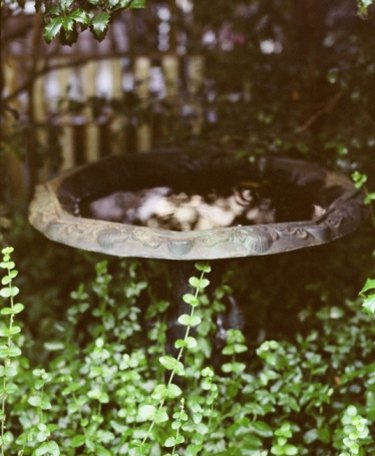
Holly bushes, such as the English holly and the American holly, are often placed in home gardens and yards for their glossy green foliage. While holly bushes are lovely, they are susceptible to diseases that affect their health and appearance. One common holly disease is powdery mildew, which causes a white powdery coating to develop on affected plants. Powdery mildew is a widespread disease found on many species of plants.
Identification
Video of the Day
Powdery mildew is named for its close resemblance to talcum powder. This disease is especially severe on holly growing in warm, dry climates. Powdery mildew is caused many different types of fungi, all of which produce the same symptoms on host plants. This fungi is superficial and does not invade the tissues of the holly. Powdery mildew is most common on holly bushes growing in areas of heavy shade, with poor air circulation. High humidity promotes disease development, but not when the leaves are wet. Powdery mildew fungi prefer to attack young succulent plant tissues, but will infect older leaves as well.
Video of the Day
Effects
Holly bushes with powdery mildew develop a white or gray talcum powder coating on leaves, flowers and stems. This coating often spreads until the entire leaf is covered on both sides. Before powdery mildew is present, infected holly bushes often develop curling or twisting leaves. Heavy coverings of powdery mildew causes leaf yellowing, brown leaves and malformed shoots. While powdery mildew does not kill host plants, heavy infection can cause holly bushes to experience premature leaf loss, making it unsightly.
Cultural Controls
Keeping your holly bushes healthy and stress free will help prevent powdery mildew. Place your holly bushes in an area that receives at least six hours of direct sunlight each day and is well-drained. Proper air circulation is important in the prevention of powdery mildew, so be sure to space your holly bushes far enough apart to promote circulation. Provide your holly bushes with adequate amounts of water, especially during times of drought. Avoid wetting foliage while watering and water early in the day to prevent disease development. Do not apply nitrogen-rich fertilizers to your holly bushes since these products promote the growth of new tissue, which is susceptible to powdery mildew. Prune out all infected limbs on your holly bushes and destroy them. Rake all infected leaves from your garden because powdery mildew fungi overwinters in dead plant tissue.
Chemical Control
Holly bushes with very severe infections of powdery mildew often require chemical control products. Fungicides are available at your local garden center and are recommended in the treatment of severe powdery mildew infections. Sulfur, neem oil and potassium bicarbonate are some products that can control powdery mildew. Chemical control methods are most successful when combined with cultural control methods. Always follow the instructions on the label for best results.